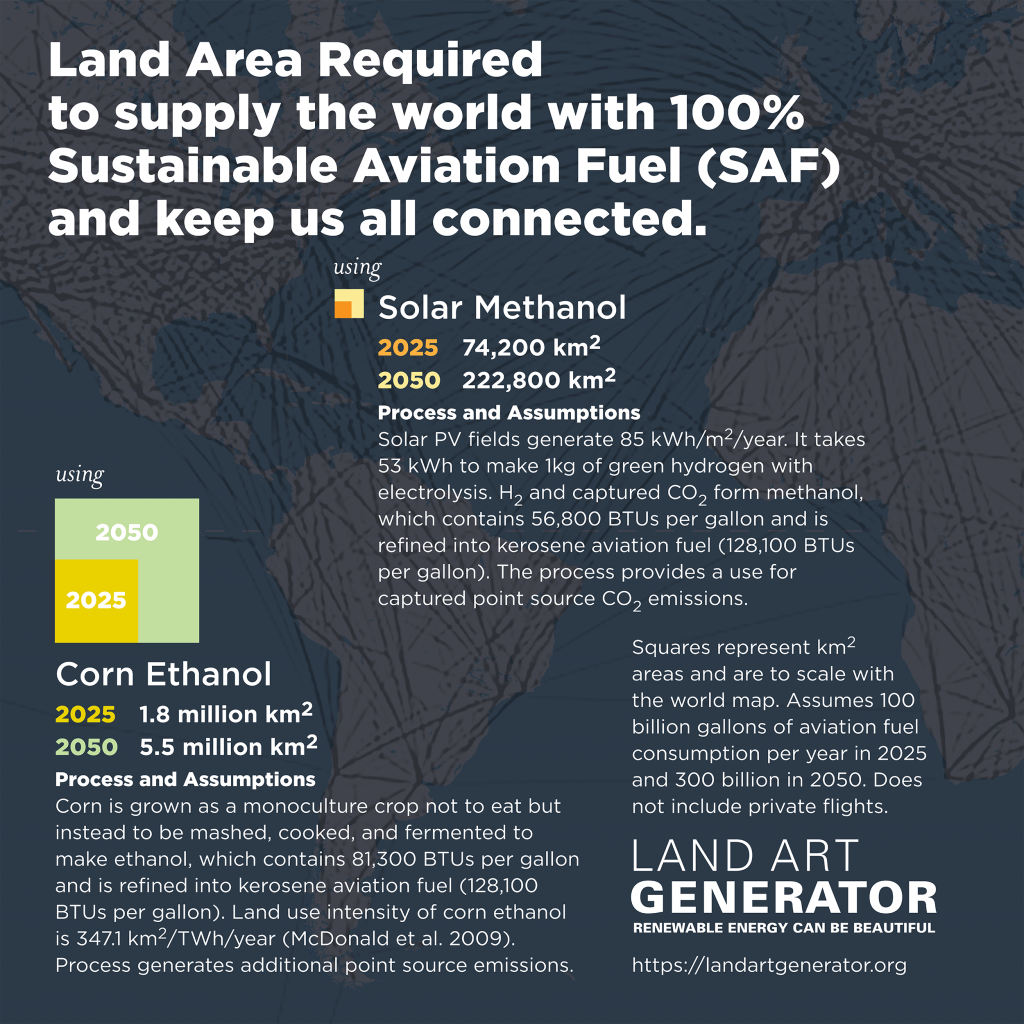
Sustainable aviation fuel (SAF) is a hot topic right now as the world is understandably not excited about doing away with what has become a defining luxury of modern life—the ability to stay connected across the globe by being anywhere on the planet on a moment’s notice. The good news is that it is possible to produce sustainable aviation fuel without using fossil fuels. The bad news is that what seems to be the politically favored option for doing it is not really sustainable at all. Unless you define sustainable as growing corn on a land area that if combined would be larger than the entire nation of India.
In this graphic we look at two methods for producing aviation fuel with (near) net-zero emissions.
- Corn Ethanol: Corn ethanol is produced by ethanol fermentation and distillation. It is debatable whether the production and use of corn ethanol results in lower greenhouse gas emissions than gasoline. Approximately 45% of U.S. corn croplands are used for ethanol production. This process generates additional point source greenhouse gas emissions that must be captured for utilization or storage. Corn is a water-intensive crop and it can take hundreds of gallons to produce a single gallon of ethanol.
The New York Times published a piece on November 30, 2023 on the issues related to corn ethanol production (Airlines Race Toward a Future of Powering Their Jets With Corn). For all of the reasons in the article, making aviation fuel from corn is not a great idea. But the real killer is the land area that would be required to accomplish this at scale. Even going by today’s air travel traffic we would need an area the size of Mexico to grow all the corn. The water requirements would be astronomical. Fortunately there is another option.
- Solar Methanol: CO2 hydrogenation technology is used to produce e-methanol from green hydrogen (solar powered electrolysis) mixed with captured carbon dioxide. This process provides a valuable use for CO2 captured at point sources (perhaps in peaker e-methanol power plants or from hard to abate industrial stacks), diverting it from the atmosphere until it is consumed in flight (in essence using the carbon twice). The complete system loop can be entirely net-zero if the CO2 comes from direct air capture. Alternatively the CO2 can be taken from the ocean (direct ocean capture) and the green hydrogen production be done with desalinated seawater. The process requires water for green hydrogen production, but not nearly as much as is required for corn ethanol irrigation.
The other interesting thing about e-methanol is that is can be used as a long duration energy storage system. With stocks of e-methanol, we can ride out long waves of overcast and windless weeks (the Dunkelflaute of Germany). By combusting the e-methanol in an Allam cycle power plant, particulate pollution is avoided entirely (NOx, SOx, carbon black), and the CO2 can be very easily captured, turned back into e-methanol, and the cycle could continue with very little residual pollution. The Allam cycle works by combusting the fuel in an oxygen-only environment rather than in ambient air. The oxygen is easily supplied as a byproduct of the electrolysis of green hydrogen from water.
Neither of these pathways is perfect, and by far the best thing for the health of the planet would be for us to all fly less. But flying is a wonder of human innovation and it would be a shame to take a step back from that progress (unless we could all travel by airship). Electric planes are also making great strides and if used for short hauls and private flights they could reduce the solar area required to meet our needs since direct use of the solar electricity is far more efficient.
As we advance into the next stage of the great energy transition, let’s use our creativity and ingenuity to keep air travel possible without harming the climate. It might require solar power landscapes that if placed together would cover Ghana or Portugal, all making green hydrogen and capturing carbon from the air and sea. It definitely won’t be easy, but it is possible. It’s just not possible using biofuels like corn.
Sources
115,385 BTUs per gallon of aviation fuel
100 billion gallons per year for commercial aviation (95 billion in 2019)
Information about solar methanol
More information about solar methanol
Land use intensity of corn ethanol
BTU energy density of fuel types
Note: An earlier version of the graphic shared on social media included incorrect numbers for solar methanol land area, but the square sizes were correct in the graphic. The version of the image and PDF in this post are all updated.
Related Posts
2 Comments
Add comment Cancel reply
This site uses Akismet to reduce spam. Learn how your comment data is processed.


I would argue that trains are a much better solution for short to medium distances then planes even without considering the enviromental impacts.
We would agree! Even for long distances if you can afford the time. This information graphic was generated as a thought piece assuming that air travel is something that the majority of people would want to maintain in a net-zero future. Travel by electric rail powered by renewable energy will always better for the environment no matter how green the aviation fuel.